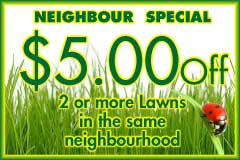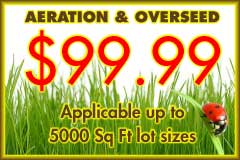|
 It is estimated that about 30 percent of all
Canadians own a pet and most if not all of them
consider that pet to be part of their family; this
means the pet is present when the family dines
outside picnic style or the family is out running
errands in the car, typically the dog is right there
with them.
It is estimated that about 30 percent of all
Canadians own a pet and most if not all of them
consider that pet to be part of their family; this
means the pet is present when the family dines
outside picnic style or the family is out running
errands in the car, typically the dog is right there
with them.
A pet friendly lawn is a
‘must-have’ especially for dogs that frequently uses
the backyard for their potty. A good idea is to
train the dog or puppy from the day they arrive to
go in a certain area of the yard to do their
‘business.’ This could be a corner of the yard near
the back of the fence or behind some shrubs. The
area should be easily accessible and easy to clean –
dirt and gravel work best. Teaching the dog to jump
over short shrubs is not only a good idea, but also
entertaining for both dog owner and the
dog.
Smaller dogs, and even cats, could
benefit from ‘runs’ which are fenced ‘gates’ or like
playpens for animals only they have a fence on the
top as well. Some of these runs are made with a
concrete bottom for easy clean up while other simply
set on the grass. Used in combination with a dog
door would allow your indoor cat the freedom to
explore the outdoors without fear of running off or
getting hurt. A fenced pen or run placed under a
window with a small dog door installed in it makes
the prefect escape for Miss Kitty. One could even
plant some catnip plants in the enclosed area for
the cats ultimate enjoyment.
Medium and
larger size dogs would benefit from a fenced-in back
yard in which they could run freely without the
constraints of a chain. Beware of ‘invisible
fencing’ because once a dog breaks loose – runs over
the fencing – after another dog or squirrel, then
they will be prone to do it again and again,
regardless of the consequences. Some underground
fences state on the box that supervision should be
considered but this defeats the purpose of having a
fence in the first place.
When considering
landscaping choices and your pet, choose with your
pet in mind because chances our, the pet will be
spending more time outdoors then the family
will.
Use hardscape materials that offer
low maintenance and a contemporary alternative to
grass for high traffic areas – choose from etched
concrete, bricks, crushed stone mulch or flagstone.
Use green alternatives or sturdier grasses. Grasses
such as Bermuda or Kentucky Bluegrass hold up to
foot or paw traffic fairly well. For an alternative,
try clover lawns which do not stain from dog urine
the way other grasses do.
Create decorative
yet functional barriers to keep pets away from
delicate foliage. Wire will stop a dog from tearing
at a sensitive tree trunk while small fencing should
protect flower beds.
Find your dogs natural
pathways and avoid moving them for dogs are
territorial. Use paver blocks or other hardscape
materials and leave gravel near the fence.
|



 It is estimated that about 30 percent of all
Canadians own a pet and most if not all of them
consider that pet to be part of their family; this
means the pet is present when the family dines
outside picnic style or the family is out running
errands in the car, typically the dog is right there
with them.
It is estimated that about 30 percent of all
Canadians own a pet and most if not all of them
consider that pet to be part of their family; this
means the pet is present when the family dines
outside picnic style or the family is out running
errands in the car, typically the dog is right there
with them.